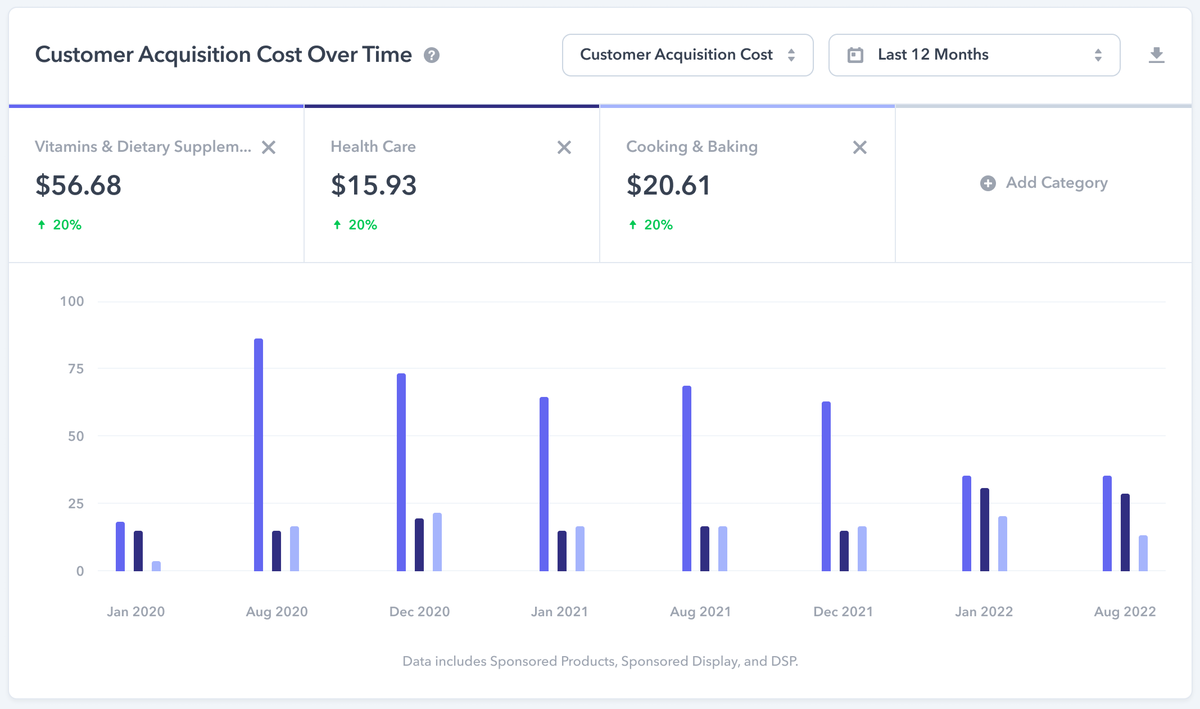
5 targeting strategies you can only pursue with AMC Audiences
Stephen Bench-Capon, June 22, 2023
Table of Contents
Even the most sophisticated advertisers, who understand that experimentation, testing, and refinement are the keys to success, can be limited by the tools—and the data—they have access to. That's why AMC Audiences are so exciting. Advertisers can now build custom audiences using data from the Amazon Marketing Cloud (AMC), meaning that they are now limited only by their imagination. To get you started, and to serve as inspiration, we've compiled five of our favorite targeting strategies that leverage the unique power of AMC Audiences.
What are AMC Audiences?
AMC Audiences are a powerful way for advertisers to build custom audiences for targeting with their Amazon DSP campaigns. The customization possibilities are literally limitless, as advertisers can write their own SQL queries, and incorporate data from all of the sources that feed into their Amazon Marketing Cloud instance. They can even include their own 1st party signals (from for example, their DTC site), if they import these into the AMC.
How are AMC Audiences different from existing Amazon DSP audiences?
While they both enable the creation of a user group that you can target with Amazon DSP campaigns, AMC Audiences are unique and differ from existing Amazon DSP audiences in three main ways:
More metrics: The AMC contains datapoints, like add-to-cart and Subscribe & Save metrics, that are not accessible for regular Amazon DSP audiences.
More flexibility: AMC Audiences can include dimensions such as the frequency (how often a user has performed an action) or the order of user events (they did this, then that). This is not possible in the Amazon DSP.
No limits: AMC Audiences aren't created from existing building blocks. Advertisers can build an audience by writing any SQL query they like, with the only limitations (besides Amazon's standard size and policy restrictions) being their expertise, creativity and willingness to experiment.
Our recommended AMC Audiences strategies
We've said how limitless AMC Audiences are, but here are five strategies we've identified that let you hone in on an audience by applying thoughtful inclusion and exclusion criteria. In each case, the aim is to build an audience with a high propensity to buy based on their specific situation and the signals associated with their prior behavior.
1. Use keyword exploration behavior to identify high-intent shoppers
One of the most powerful signals an Amazon user provides is the keywords they search for. Every keyword entered into the search bar is an expression of intent to buy—or to find out more about—certain categories, brands or products. This is why keyword targeting is the cornerstone of Sponsored Products and Sponsored Brands campaigns.
With AMC Audiences, you don't just choose keywords to determine where your ads are displayed. You can target users based on their keyword search history. There are two slightly different approaches you can take:
compile a list of relevant keywords, such as those you are targeting with existing ad campaigns, and use these to create AMC Audiences
analyze user search behavior in the AMC to identify keywords (or combinations of keywords) that users typically search for before making a purchase, and target these high-intent shoppers
However you arrive at your list of high-intent keywords, you should always test the performance of ad campaigns and try out different variants to see what works best. And, as with any AMC Audience, you can also define exclusion criteria, such as users who have already seen a certain number of ads in the last 30 days, or users who have already purchased the product being advertised.
Ultimately, the aim of inclusion and exclusion criteria is to create an audience with the highest possible likelihood to purchase upon seeing the ad, while avoiding superfluous clicks from users who would have (probably) completed a purchase without seeing the ad. And this works! By targeting customers based on their keyword exploration behavior, one Perpetua customer, Beekeeper's Naturals, was able to achieve a ROAS 33% above that of their alternative campaigns.
2. Boost subscriptions by targeting repeat purchasers
For brands selling consumer packaged goods (CPGs), one strong indicator of propensity to purchase could be the fact they have purchased before. This is the idea at the heart of traditional remarketing campaigns. Any product that requires regular replacement is a perfect candidate for this kind of strategy.
You can leverage AMC Audiences to elevate this principle to another level of sophistication. Standard remarketing will capture the following users:
those who are already using Subscribe & Save for this product
those who bought the product once but only once, even though enough time has passed to justify a repeat purchase.
The ability to exclude both of these groups from your custom AMC Audience ensures that your ads are only displayed to users who have purchased your product at least twice (or at least three times—this is the perfect place for you to experiment), and who have not yet activated Subscribe & Save.
Getting specific with your targeting also opens up possibilities for more tailored ad creatives. With this audience, you can explicitly highlight the option to Subscribe & Save in your ads, and use this to drive up not just repeat purchases, but subscription rates, too.
NOTE: If you are running a campaign with the aim of increasing the number of customers who subscribe to your product, then make sure that you use the AMC's reporting capabilities to track performance and see how this metric develops.
3. Find the sweet spot when users are ready to buy
One user audience you might wish to target is those who have visited your Product Detail Page (PDP), but not yet purchased. This would be more applicable to larger, one-off purchases that require more research, rather than CPG products, as shoppers consider a range of different products and visit several PDPs.
With Amazon DSP audiences, you can choose to target users who have visited your PDP but who haven't bought your product, but that's as far as it goes. With AMC Audiences, you can specify how often someone has to have visited your PDP to be included in your targeting. This lets you fine-tune your audience to hit the sweet spot of the funnel when users are on the cusp of moving from consideration to purchase-readiness.
In terms of propensity to buy, you could argue that this strategy targets a user group with a track record of failing to convert. This is why testing is critical here. You can run multiple campaigns to experiment with different timeframes and vary the number of PDP visits required. You can also define a maximum number of PDP visits beyond which you want to exclude users.
By testing parameters, you can identify what works best for your product(s), and run a campaign that will capture this high-potential user group and prevent them from going to a competitor.
NOTE: With the AMC, you're not just building one-off audiences, you're also in a position to monitor how these audiences change. If you see the number of frequent visitors who don't purchase growing, then ask yourself: why might more people be visiting my PDP but then bouncing? This could give you cause to review the content of your listing as there could be a disconnect between the ads you are running and the information users see on the PDP.
4. Don't let add-to-cart users off the hook
In some cases, AMC Audiences give you access to metrics that aren't available to use for targeting via standard Amazon DSP audiences. An example is the add-to-cart (ATC) metric. An audience of users who have added your product to their shopping cart, but who haven't completed the purchase, is at the lowest possible point of the funnel. This makes them well primed for retargeting.
Clearly, there may be various reasons for a shopper's failure to purchase, and you may want to add additional exclusion criteria to further refine this strategy. One option would be testing different timeframes to ensure you are capturing conversions while intent remains high, but not wasting ad spend on purchases that were near-guaranteed anyway.
5. Maximize revenue from high-LTV customers
Another feature of AMC Audiences is that they allow not just for binary true/false filters of certain user events, but for mapping out the order in which different events happen, and how often they occur. This creates possibilities that let you take control of the full user journey as they interact with your brand.
One such possibility offered by AMC is segmenting your customers according to lifetime value (LTV), and building campaigns that target those who are bringing you the most sustained revenue via repeat purchases. High-LTV customers who have proven their loyalty are perfect candidates for cross-selling campaigns or for the promotion of new products. You can find out more about LTV in our blog article: Analyzing LTV to CAC ratio with the Amazon Marketing Cloud.

Get started with AMC Audiences
If these five strategies sound a little daunting to implement, don't worry. Perpetua has AMC Audiences fully integrated into its Amazon DSP solution, meaning that you can easily setup and activate an advanced, AMC-powered audience for your Amazon DSP campaigns.
And if you've got your own strategies you want to try out, even better! Our team of AMC experts are ready and excited to provide support in building custom AMC Audiences to maximize the precision of your campaigns and boost your advertising performance.
Want to learn more about AMC Audiences?
Find out how you can use Perpetua to build custom Amazon Marketing Cloud Audiences and take your targeting to the next level.
To get started or learn more about how Perpetua can help you scale your Amazon Advertising business, contact us at hello@perpetua.io